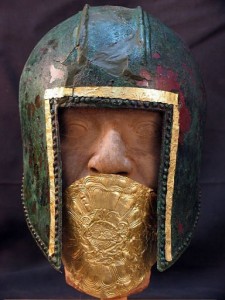 Excavations of the Iron Age cemetery in Pella keep turning up huge numbers of finds. Thursday archaeologists announced that they’ve found another 37 tombs dating from 650 to 280 B.C. One of the tombs was the final resting place of a warrior from the 6th century B.C. and it held a bronze helmet with a gold mouthplate, weapons and jewelry.
Excavations of the Iron Age cemetery in Pella keep turning up huge numbers of finds. Thursday archaeologists announced that they’ve found another 37 tombs dating from 650 to 280 B.C. One of the tombs was the final resting place of a warrior from the 6th century B.C. and it held a bronze helmet with a gold mouthplate, weapons and jewelry.
These treasures aren’t quite as elaborate as the accouterments found in 43 graves last year, but these tombs too are an incredibly rich source of ancient Macedonian artifacts ranging from ceramics to precious metals. Overall, archaeologists have uncovered an astonishing 1,000 tombs since excavations of the site began 10 years ago, and they’ve only excavated an estimated 5% of the site.
They’ve found so many ancient artifacts that Greek Ministry of Culture and Tourism spent 1.6 million euros building a new Archaeological Museum of Pella. The old museum was built in 1960 to store the finds. It was quite teeny — it only had 3 rooms — but it had had to function as the sole archaeological museum since 1973. The new museum has 6,000 square meters (a whopping 65,000 square feet) of display space, all of it packed with archaeological wonders.
Among the most important exhibits are six mosaics from houses (depicting Dionysus riding a panther, a lion-hunt, a griffin attacking a deer, a pair of centaurs, and vegetal ornaments), an interior wall of a house decorated with coloured plaster in the first Pompeian style (2nd century BC), a marble portrait head of Alexander the Great and a marble statuette of Alexander as Pan of the Hellenistic period, a small bronze statue of Poseidon attributed to the sculptor Lysippos, also of the Hellenistic period, hoards of silver coins of the Macedonian kings (5th century BC) and of the Hellenistic period, a red-figure hydria decorated with a representation of Poseidon’s duel with Athena, dated to the late fifth or early fourth century BC, and a headless statue of a youth on horseback.



Pella was the second ancient capital of Macedonia (Aigai, another rich source of archaeological finds, was the first). Archelaus (413–399 BC) made it his capital and it remained so through Philip II’s and Alexander’s times. It was sacked by Roman troops in 168 B.C., when the last Antigonid king, Perseus of Macedon, was deposed and killed. Shortly thereafter an earthquake silted the harbor and the city’s decline was sealed.
Congratulations, Macedonia!
These artifacts seem wondrous and a great treasure for us to behold. I want to go to the museum and see for myself!
It looks like a great museum, doesn’t it? Such a wealth of beautiful artifacts to display.
I was in Pella in July and can attest to the quality of the museum. But woe to anyone trying to get there via public transport as the museum and tumulous are outside the town and there is NOTHING else in the town besides homes – but worth the 2 hour hike and 4 hours waiting for a bus in torential rain nonetheless.
Greece has a strange habit of making appreciation of its history incredibly difficult.
😆 That’s even more difficult than my childhood recollections, and I recall complaining about a LOT of walking. It must be an amazing museum to have been worth all that.